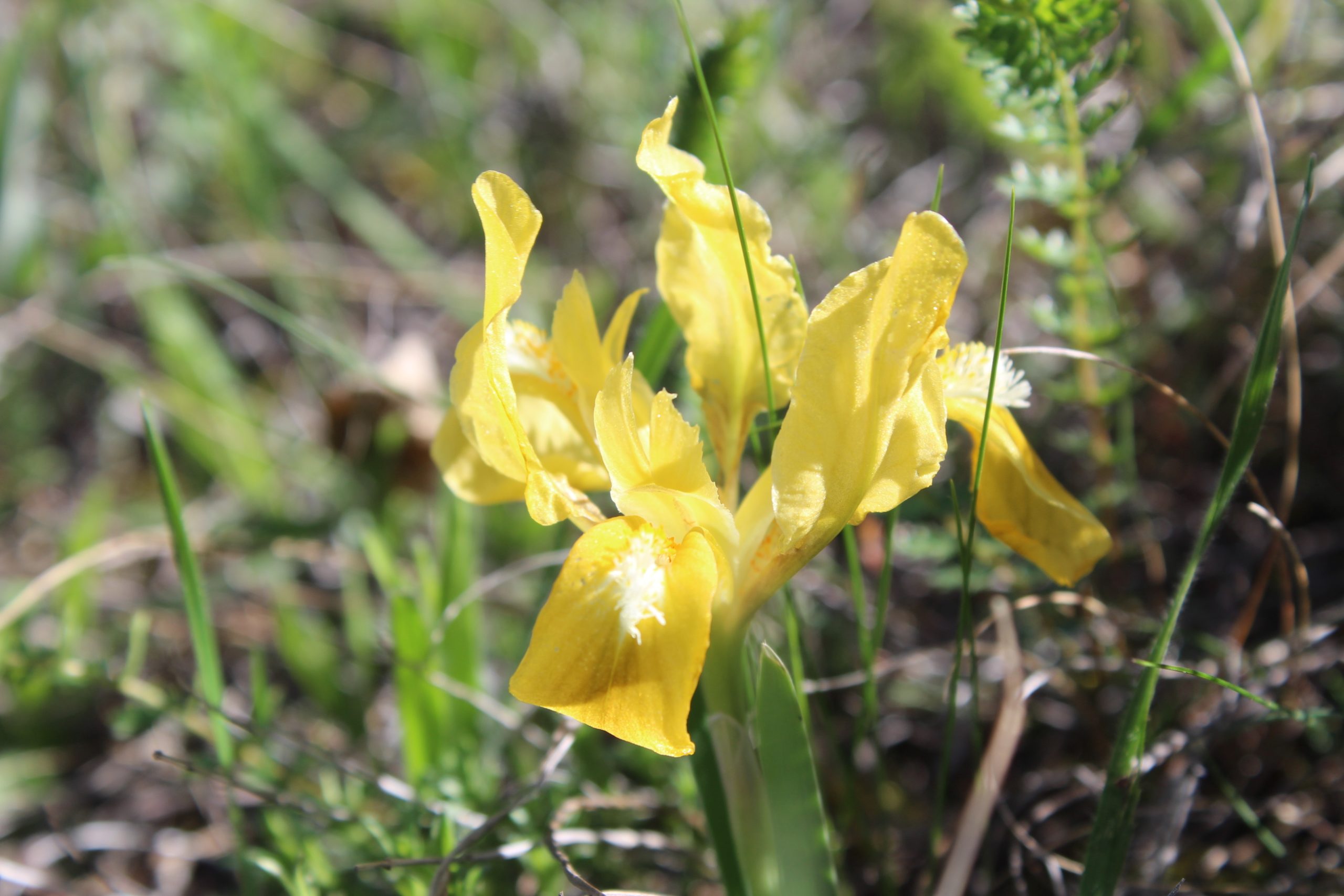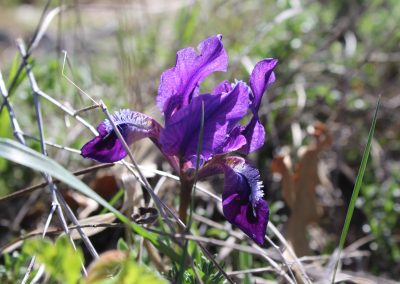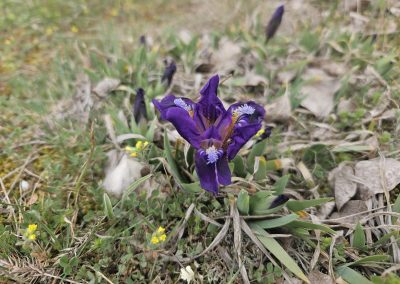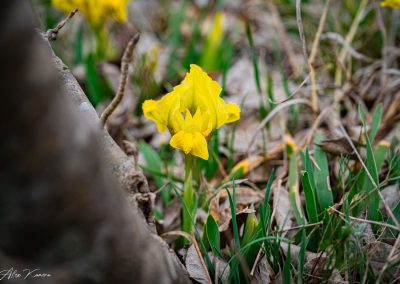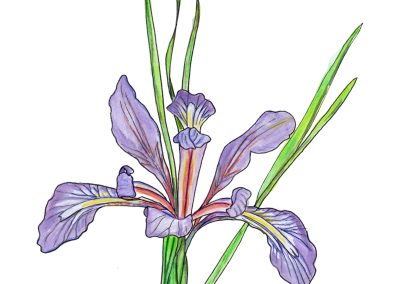Iris Pontica
Scientific description
Phylum: Angiospermatophyta (Magnoliophyta)
Class: Monocotyledonatae (Liliatae)
Subclass: Liliidae
Order: Liliales
Family: Iridaceae
Origin: native to the areas bordering the Black Sea and the Mediterranean.
Description:
It is a perennial herbaceous plant. The root is a short, thick, lemony and branched rhizome from which the cylindrical flowering stem, several cm long and branched, arises, bearing several sword-shaped leaves. It has 2–5 basal leaves, narrow, linear-lanceolate, 10–45 cm long, larger than the stem. The stem ends with a single inflorescence. Each flower has at its base a bract that becomes parchment-like at maturity, with two or three bluish bracts. The flower consists of six petaloid perigonal leaflets: three outer ones (“falls”) are sub-orbicular or obovate, purple or reddish-purple, darker veined, and lower midvein half hairy (yellowish/greenish yellow); three inner leaflets (“standards”) are oblanceolate, unguiculate, light purple. Leaflets slightly joined at base forming a short purplish-green tube. Androecium: three long stamens in front of outer leaflets, long anthers, violaceous filaments. Gynoecium: tricarpellar, syncarpous, inferior; style apex with three petaloid stigmas, two yellowish lobes covering the stamens. Blooms spring–summer. Fruit: ellipsoidal capsule with pyriform reddish-brown seeds.
Propagation: by division of the rhizomes.
Ecology:
Grows spontaneously in clearings and meadows, prefers calcareous, sandy-clay soils.
Uses:
Planted in gardens and parks as a decorative plant. Leaves and flowers are rich in vitamin C. Expectorant and diuretic; can be used internally as infusion or decoction to prevent pneumonia, headache, tuberculosis, relieve constipation and menstrual pain. Can be applied in compresses for dental neuralgia, burns, and skin mycoses.
Remark: Continental element, critically endangered, very rare plant.
Încrengătura: Angiospermatophyta (Magnoliophyta)
Clasa: Monocotyledonatae (Liliatae)
Subclasa: Liliidae
Ordinul: Liliales
Familia: Iridaceae
Origine: originară din zonele limitrofe Mării Negre și Mediterane.
Descriere:
Este o plantă ierboasă perenă. Rădăcina este un rizom scurt, gros, lemnos și ramificat, de care se prinde tulpina floriferă cilindrică, câțiva cm lungime, ramificată, pe care sunt dispuse mai multe frunze enziforme. Are 2–5 frunze bazale, înguste, liniare-lanceolate, 10–45 cm lungime, mai mari decât tulpina. Tulpina se termină cu o inflorescență unipară. Fiecare floare are la bază o bractee pergamentoasă la maturitate și două-trei bractee albăstrui. Floarea are șase foliole perigonale: trei externe (“căderi”), sub-orbiculare sau obovate, violet sau roșcat-violet, cu nervuri mai închise și jumătate inferioară a nervurii mediene acoperită cu peri gălbui/galben-verzui; trei interne (“standarde”), oblanceolate, unguiculate, violet deschis. Foliolele se unesc ușor la bază, formând un tub scurt, verzui-violaceu. Androceul: trei stamine lungi în fața foliolelor externe, antere lungi, filament violaceu. Gineceul: tricarpelar, sincarp, inferior, cu trei stigmate petaloide la vârf, doi lobi gălbui, acoperind staminele. Înflorește primăvara–vara. Fructul: capsulă elipsoidă cu semințe piriforme maro-roșcat.
Înmulțire: prin divizarea rizomilor.
Ecologie:
Crește spontan în poieni și pajiști, preferă soluri calcaroase, nisipoase-argiloase.
Utilizare:
Plantă decorativă în grădini și parcuri. Frunzele și florile sunt bogate în vitamina C. Acțiune expectorantă și diuretică; utilizare internă (infuzie/decoct) pentru prevenția pneumoniei, cefalee, tuberculoză, constipație, dureri menstruale. Utilizare externă în comprese pentru nevralgii dentare, arsuri și micoze ale pielii.
Pericol: Element continental, taxon critic periclitat, plantă foarte rară.
Φύλο: Αγγειόσπερμα (Magnoliophyta)
Κλάση: Μονοκοτυλήδονα (Liliatae)
Υποκλάση: Liliidae
Τάξη: Λειριανθώδη (Liliales)
Οικογένεια: Ιριδοειδή (Iridaceae)
Καταγωγή: από παραθαλάσσιες περιοχές Μαύρης Θάλασσας και Μεσογείου.
Περιγραφή:
Πολυετές ποώδες φυτό. Η ρίζα είναι κοντόχοντρο, ξυλώδες και διακλαδισμένο ρίζωμα, από το οποίο αναπτύσσεται ο κυλινδρικός λουλουδοφόρος βλαστός, λίγων εκατοστών, διακλαδισμένος, φέρει ξιφοειδή φύλλα. Έχει 2–5 βασικά φύλλα, στενά, γραμμικά-λογχοειδή, 10–45 εκ., μεγαλύτερα από τον βλαστό. Ο βλαστός τελειώνει σε μονόπλευρη ταξιανθία. Κάθε άνθος στη βάση έχει βράκτιο μεμβρανώδες στην ωρίμανση και 2–3 μπλε βρακτιά. Άνθος με έξι πέταλα: τρία εξωτερικά (“πτώσεις”), στρογγυλά ή ανεστραμμένα ωοειδή, μωβ/κοκκινο-μωβ, σκούρες νευρώσεις, κάτω μισό τρίχωμα κίτρινο/κιτρινοπράσινο. Τρία εσωτερικά (“standards”), λογχοειδή, στενόμυρα, ανοιχτό μωβ. Πέταλα ενώνονται στη βάση, σχηματίζουν κοντό σωλήνα πρασινο-μωβ. Ανδρείο: 3 στήμονες μπροστά από τα εξωτερικά πέταλα, μακριές ανθήρες, ιώδης μίσχος. Γυναικείο: τρίκαρπο, σύγκλειστο, κατώτερο, 3 στίγματα πεταλοειδή με δύο κίτρινους λοβούς. Ανθίζει άνοιξη-καλοκαίρι. Καρπός: ελλειψοειδής κάψα με κόκκινα-καφέ αχλαδόμορφα σπόρια.
Πολλαπλασιασμός: Με διαίρεση των ριζωμάτων.
Οικολογία:
Αυτοφύεται σε ξέφωτα και λιβάδια, προτιμά ασβεστολιθικά ή αμμώδη-πηλώδη εδάφη.
Χρήση:
Καλλωπιστικό σε κήπους και πάρκα. Φύλλα και άνθη πλούσια σε βιταμίνη C. Αποχρεμπτικές και διουρητικές ιδιότητες. Χρήση εσωτερικά ως έγχυση ή αφέψημα για πρόληψη πνευμονίας, κεφαλαλγίας, φυματίωσης, ανακούφιση δυσκοιλιότητας και πόνων περιόδου. Εξωτερικά σε κομπρέσες για νευραλγίες δοντιών, εγκαύματα, μυκητιάσεις δέρματος.
Κίνδυνος: Σπάνιο φυτό, κρίσιμα απειλούμενο, στοιχείο ηπειρωτικού χαρακτήρα.
Embranchement : Angiospermatophyta (Magnoliophyta)
Classe : Monocotyledonatae (Liliatae)
Sous-classe : Liliidae
Ordre : Liliales
Famille : Iridaceae
Origine : Originaire des régions bordant la mer Noire et la Méditerranée.
Description :
Plante herbacée vivace. La racine est un rhizome court, épais, citronné et ramifié, duquel part une tige florale cylindrique, plusieurs cm de long, ramifiée, portant plusieurs feuilles en forme d’épée. Elle possède 2 à 5 feuilles basales, étroites, linéaires-lancéolées, de 10 à 45 cm, plus grandes que la tige. La tige se termine par une seule inflorescence. Chaque fleur a à sa base une bractée devenant parcheminée à maturité, accompagnée de deux ou trois bractées bleuâtres. La fleur comprend six tépales : trois externes (“falls”), sub-orbiculaires ou obovées, violettes ou rouge violacé, nervures plus foncées, moitié inférieure des nervures médianes velue (jaune/vert-jaune) ; trois internes (“standards”), oblancéolées, unguiculées, violet clair. Les six tépales légèrement soudés à la base, formant un court tube vert-pourpre. Androcée : trois longues étamines en face des tépales externes, anthères longues, filet violacé. Gynécée : tricarpellaire, syncarpe, infère ; apex du style avec trois stigmates pétaloïdes à deux lobes jaunâtres recouvrant les étamines. Floraison printemps–été. Fruit : capsule ellipsoïde avec graines piriformes brun-rougeâtre.
Multiplication : par division des rhizomes.
Écologie :
Se développe spontanément dans les clairières et prairies, préfère sols calcaires, sablo-argileux.
Utilisation :
Plante décorative dans jardins et parcs. Feuilles et fleurs riches en vitamine C. Action expectorante et diurétique ; utilisation interne (infusion/décoction) pour prévenir pneumonie, maux de tête, tuberculose, constipation et douleurs menstruelles. Application externe en compresses pour névralgies dentaires, brûlures et mycoses cutanées.
Remarque : Élément continental, taxon en danger critique d’extinction, plante très rare.
Creative writing inspired by Iris Pontica
The Path of Iris
Long ago, when gods still walked among mortals, the skies wept with sorrow for a world that had forgotten beauty. The flowers drooped, the rivers ran gray, and even the stars dimmed their light.
Among the gods, Iris—messenger of Olympus and keeper of the rainbow—watched from above with a heavy heart. She, who once danced across the sky, painting it with vivid colors, had not been summoned for a long time. Without messages to carry or prayers to answer, her wings lost their luster. But one day, she heard the whisper of a mortal’s voice—soft, trembling, and honest.
A girl knelt in a barren meadow, hands cupped over a single, withering bloom. “Please,” she whispered, “bring back the colors. Let the world remember beauty.” Touched, Iris descended, her feet barely brushing the earth. From her robe, she plucked a strand of rainbow light and pressed it into the soil beside the flower. Where it touched, colors erupted—violet, indigo, gold—spreading like fire through the field. From each spark bloomed a flower shaped like a teardrop caught in flight: the iris. The girl watched, eyes wide, as Iris smiled. “Whenever the world forgets color,” the goddess said, “these flowers will remind it.” Then she vanished on a trail of light, arching once more into the heavens.
To this day, when the wind whispers through a field of irises, it’s said to be Iris herself, returning to carry a message—of hope, of beauty, or of a soul ready for its journey home.


